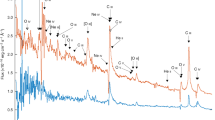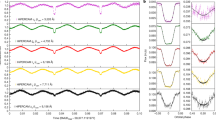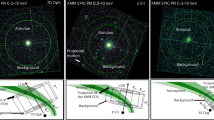Abstract
CYGNUS X-3 is one of the most luminous X-ray sources in the Galaxy1,2, a bright infrared source3 and a radio source that undergoes huge outbursts4. The system is a binary, presumably a neutron star plus companion, with a 4.79-h orbital period that modulates the X-ray and infrared emission5,6 and that increases on a 600,000-year timescale7,8. Radio observations reveal the presence of a relativistic jet9. The nature of Cyg X-3 has remained unclear, however, in part because the large interstellar extinction3 in its direction prevents optical spectroscopy. Upper limits on spectral features in the near infrared have been reported previously10, but only with recent instrumental improvements have we become able to identify spectral features in the near infrared I and K bands. These are found to be characteristic of Wolf–Rayet stars: strong, broad emission lines of HeI and HeII, but no strong hydrogen lines. These observations strongly suggest the presence of a dense wind in the Cyg X-3 system, and may indicate that the companion is a fairly massive helium star, as had been predicted11 by a model in which the present system is a descendant of a massive X-ray binary.
This is a preview of subscription content, access via your institution
Access options
Subscribe to this journal
Receive 51 print issues and online access
$199.00 per year
only $3.90 per issue
Buy this article
- Purchase on Springer Link
- Instant access to full article PDF
Prices may be subject to local taxes which are calculated during checkout
Similar content being viewed by others
References
Giacconi, R., Gorenstein, P., Gursky, H. & Waters, J. R. Astrophys. J. 148, L119–127 (1967).
Dickey, J. M. Astrophys. J. 273, L71–73 (1983).
Becklin, E. E., Kristian, J., Neugebauer, G. & Wynn-Williams, C. G. Nature phys. Sci. 239, 130–131 (1972).
Gregory, P. C. et al. Nature phys. Sci. 239, 114–117 (1972).
Becklin, E. E. et al. Nature 245, 302–304 (1973).
Mason, K. O. et al. Astrophys. J. 207, 78–87 (1976).
Manzo, G., Molteni, D. & Robba, N. R. Astr. Astrophys. 70, 317–318 (1978).
Van der Klis, M. & Bonnet-Bidaud, J. M. Astr. Astrophys. 214, 203–208 (1989).
Molnar, L. A., Reid, M. J. & Grindlay, J. E. Astrophys. J. 331, 494–508 (1988).
Katz, J. I., Wright, E. L. & Lawrence, C. R. Astr. J. 89, 1604–1605 (1984).
Van den Heuvel, E. P. J. & De Loore, C. Astr. Astrophys. 25, 387–395 (1973).
Conti, P. S. & Underhill, A. B. O-type Stars and Wolf-Rayet Stars (NASA SP-497,1988).
Conti, P. S. in IAU Symp. No. 99: Wolf-Rayet Stars: Observations, Physics, Evolution (eds de Loore, C. W. H. & Willis, A. J.) 3–19 (Kluwer, Dordrecht, 1990).
Conti, P. S., Massey, P. & Vreux, J. M. Astrophys. J. 354, 359–371 (1990).
Williams, P. M. in IAU Symp. No. 99: Wolf-Rayet Stars. Observations, Physics, Evolution (eds de Loore, C. W. H. & Willis, A. J.) 73–78 (Kluwer, Dordrecht, 1990).
Hillier, D. J. in IAU Symp. No. 99: Wolf-Rayet stars: Observations, Physics, Evolution (eds de Loore, C. W. H. & Willis, A. J.) 225–228 (Kluwer, Dordrecht, 1990).
Hillier, D. J., Jones, T. J. & Hyland, A. R. Astrophys. J. 271, 221–236 (1983).
Hillier, D. J. Astr. J. 90, 1514–1518 (1985).
Smith, L. F. & Hummer, D. G. Mon. Not. R. astr. Soc. 230, 511–534 (1988).
White, N. E. & Holt, S. S. Astrophys. J. 257, 318–337 (1982).
Van der Hucht, K. A., Conti, P. S., Lundström, I. & Stenholm, B. Space Sci. Rev. 28, 227–306 (1981).
Flannery, B. P. & Van den Heuvel, E. P. J. Astr. Astrophys. 39, 61–67 (1975).
Divine, N. Astrophys. J. 142, 824–840 (1965).
Langer, N. Astr. Astrophys. 210, 93–113 (1989).
Schmutz, W., Hamann, W.-R. & Wessolowski, U. Astr. Astmphys. 210, 236–248 (1989).
Davidsen, A. & Ostriker, J. P. Astrophys. J. 189, 331–338 (1974).
Pringle, J. E. Nature 247, 21–22 (1974).
Bonnet-Bidaud, J. M. & Van der Klis, M. Astr. Astrophys. 101, 299–304 (1981).
Wagner, R. M., Kreidl, T. J., Bus, S. J. & Williams, W. Astrophys. J. 346, 971–975 (1989).
Geballe, T. R., Burton, M. G. & Isaacman, R. Mon. Not. R. astr. Soc. 253, 75–79 (1991).
Author information
Authors and Affiliations
Rights and permissions
About this article
Cite this article
van Kerkwijk, M., Charles, P., Geballe, T. et al. Infrared helium emission lines from Cygnus X-3 suggesting a Wolf-Rayet star companion. Nature 355, 703–705 (1992). https://doi.org/10.1038/355703a0
Received:
Accepted:
Issue Date:
DOI: https://doi.org/10.1038/355703a0
This article is cited by
-
Extreme particle acceleration in the microquasar Cygnus X-3
Nature (2009)
-
Long gamma-ray burst progenitors: boundary conditions and binary models
Astrophysics and Space Science (2007)
-
Atmospheric Eclipses in Wr+o Binaries: From Kopal and Shapley to Present Days
Astrophysics and Space Science (2005)
-
Spectral measurements of Cyg X-3: A thermal source embedded in hot plasma within a cold shell
Journal of Astrophysics and Astronomy (2002)
-
X-ray spectroscopy of Cygnus X-3
Journal of Astrophysics and Astronomy (2002)
Comments
By submitting a comment you agree to abide by our Terms and Community Guidelines. If you find something abusive or that does not comply with our terms or guidelines please flag it as inappropriate.



